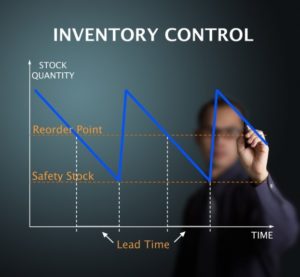The Importance of Inventory management in Online Sales Business
Inventory management is the set of activities involved in ensuring that items needed for the business to run are always available in ideal quantities. This means that there should neither be too much purchased nor too little, but just the amount required with adequate backup.

In the world of online business today, customers expect the process of buying online to be as seamless – if not more – than purchasing the same item in a store. Online sales in 2017 as a percentage of total retail sales continue to increase over last year and the market is not showing any signs of slowing down. Applying both to businesses in the B2B and B2C space, this means companies must be able to efficiently serve customers online, ship product quickly and either provide free shipping or ship at the lowest possible cost, in order to remain competitive.
The best way to efficiently manage the processes associated with buying and selling product online is to implement a vigorous front-end website for order entry and integrate this website with a sophisticated back-end inventory and accounting solution. Integration allows information such as order details, pricing, product descriptions, inventory quantities etc. to flow bi-directionally between systems. Once a customer places an order online, the key is act quickly and at the lowest cost possible ship the right product to the right customer. This is where proper inventory management software comes into play.
Before a customer can place an order online or even view a product, inventory information needs to be available. With Online business integration, once you receive inventory into your warehouse and update quantities in your inventory system, this data is pushed online for the customer to see. As you continue to receive new quantities of product, or inventory is sold via other sales channels (such as phone, email or at a tradeshow), the updated information gets reflected online. This means that customers always have up-to-date inventory quantity details. Want to change a product’s pricing, description or image? The same applies, where the user updates information in your back-end inventory system and this gets reflected online – eliminating the need to update multiple databases and software applications.
Once customers have access to accurate information, they can place an order for product online. This order then flows directly into your inventory system where it can be subject to a manual review process or automated workflow depending on how you want it set up. For example, if the order meets certain criteria already defined in the system, the software marks the order as ready to ship and sends it to the warehouse for picking. This criterion may include the system checking that the order is under a certain dollar amount, checking that the inventory is available in stock, and checking that the customer has submitted valid credit card information online. Alternatively, if you prefer to have a manual check process, the system categorizes all orders coming from the website and then holds them for review before users can send them to the warehouse.
Once employees in the warehouse receive the order for picking, packing and shipping, they can choose to do so manually using pen and paper or with the help of mobile picking devices or verification scanning. Barcode scanning helps to ensure that employees pick the right items and the right quantity to reduce the number of shipping errors. Employees then pack items for shipping and the system will print the appropriate shipping documents. Once again, depending on how the system has been configured, it can automatically mark the order as shipped and then send the appropriate information back through the inventory system to appear on the Online business site or be emailed to the customer.
Without the right systems in place for managing the entire order process and inventory, sales orders get missed, inventory quantities are wrong, items need to be backordered, the wrong items get shipped and customers become frustrated. Even with introductory software, managing orders involves multiple steps and checks and is prone to human error. Before you start selling online, consider your options for inventory management.
The key to the Growth of your Online Business is to retain healthy inventory management system. If you’re an Online business retailer, you probably fall into one of three categories.
- You dabble: As in, you’re not expecting much to come out of it. You have some sales from friends and family, but no real traction yet.
- You’re growing: You’re realizing that your side store has more potential than you thought. Maybe you move from selling on Instagram or a blog site to using a platform specifically for Online business like Shopify to set up a real store.
- You’re it: You’re running an efficient business with multiple channels. The decisions facing you are high level – you have softwares that you love – handling all the details so you can focus on what’s important.
How Automation facilitate your growth?
Each inventory management software, but most multi-channel ones can grow your sales through the following features:
Order Management: Rather than estimating how much stock you need to order and worrying that you might buy too much or too little, the software can automatically tell you when you need more of a product. As a retailer, you’ll avoid missing out on sales due to out-of-stock situations, but also avoid having surplus stock that’s doomed to gather dust in a corner.
Product Identification and Tracking: The software allows you to assign unique bar-codes with information about each item, so all you have to do is scan an item at the point of sale. Your stock levels and profits update automatically – it’s that easy. You can also track when you move things between different store locations or warehouses.
Automation: In other words, doing everything that would take you hours or days by hand in a matter of seconds. The software allows you to keep track of how your items are selling – useful if you’re planning a marketing campaign or deciding which items to put on sale. You can generate reports on-the-go – in real time so that there is no delay and you can always make informed strategy decisions.
Best features for Onlone retailers
It’s no secret that Online business is a growing industry, and inventory management systems have your back on this. These features can be particularly helpful in managing your online site.
Warehouse integration – If you’re an online store trying to get a physical store, or vice versa, you can manage the inventory from both sales channels all in one place. The expansion doesn’t have to be painful.

Integrations with eCommerce Platforms – If you’re hosting your site from an eCommerce platform like Shopify or WooCommerce, good inventory management software will likely have integrations linked to them. These integrations assure that when someone makes a purchase online, all the items in their shopping cart are synced to all sales channels. Just like with a physical, in store purchase, the warehouse and the supplier will automatically know that they are down in stock. You don’t need a separate account or software to manage your site.
Real Time Updates – As a consumer, have you ever fallen in love with a cute pair of shoes and added it to your online cart, only to have it read “out of stock” when you click the checkout button? No one likes reading error or apology messages. A multi-channel system will keep this from happening again.
Tracking – With a physical store, you have some items back in the warehouse and some in the actual store. With an online store, you may have items that you haven’t published yet but that you plan to – very soon, strategically timed. You can keep track of what you’ve published and what you haven’t and manage your total inventory.
Reference
http://www.bluelinkerp.com/blog/2017/07/05/importance-inventory-management-ecommerce-2017/
